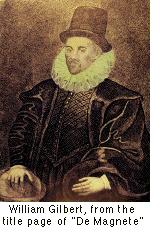 William Gilbert came from a wealthy middle class family. He studied at Cambridge University from 1558,obtained a B.A. 1561, an M.A. in 1564 and his M.D. in 1569.
William Gilbert came from a wealthy middle class family. He studied at Cambridge University from 1558,obtained a B.A. 1561, an M.A. in 1564 and his M.D. in 1569.Physicist and physician, b. 24 May 1544 (Colchester, England), d. 10 December (30 November) 1603 (London or Colchester).
 William Gilbert came from a wealthy middle class family. He studied at Cambridge University from 1558,obtained a B.A. 1561, an M.A. in 1564 and his M.D. in 1569.
William Gilbert came from a wealthy middle class family. He studied at Cambridge University from 1558,obtained a B.A. 1561, an M.A. in 1564 and his M.D. in 1569.
After completion of his studies Gilbert was appointed a senior fellow of St. John's College of the university. In 1573 he established himself as a physician in London and joined the Royal College of Physicians. In 1600 he was elected its president. He became physician to Queen Elizabeth I in 1601 and upon her death in 1603 physician to King James I.
Gilbert became interested in the phenomenon of magnetism and studied the properties of magnetic needles and loadstone for many years. By shaping a loadstone into a ball and holding a compass needle close to it he showed that every magnet, including the needle but also the ball, has a north pole and a south pole. Noticing that the needle points more and more downward as it is brought closer to one of the poles of the ball and lnowing that seamen had observed the same effect with their compass needles he concluded that the Earth acts as a massive bar magnet.
Gilbert described his groundbreaking research in 1600 in his work De Magnete, Magneticisque Corporibus, et de Magno Magnete Tellure ("On the magnet, magnetic bodies, and the great Earth magnet", published in English as William Gilbert of Colchester ... on the Great Magnet of the Earth in 1893). The work became a standard textbook for scientists throughout Europe.
Gilbert's research was pioneering in several respects. He was the first European to distinguish between magnetism and static electricity and introduced the terms electric attraction, electric force and magnetic pole. Although he described the Earth's magnetic field in somewhat spiritual terms, calling magnetism the soul of the Earth, he derived conclusions far ahead of his time. Among his theoretical conclusions was that the Earth must rotate around its axis to produce an associated magnetic field.
After Gilbert's death his half-brother edited his unfinished work under the title De Mundo Nostro Sublunari Philosophia Nova ("New Philosophy about our Sublunary World").
Golden, F. (1972) The moving continents. Charles Scribner's Sons, New York.
William Gilbert. Encyclopaedia Britannica 15th ed. (1995)